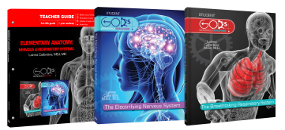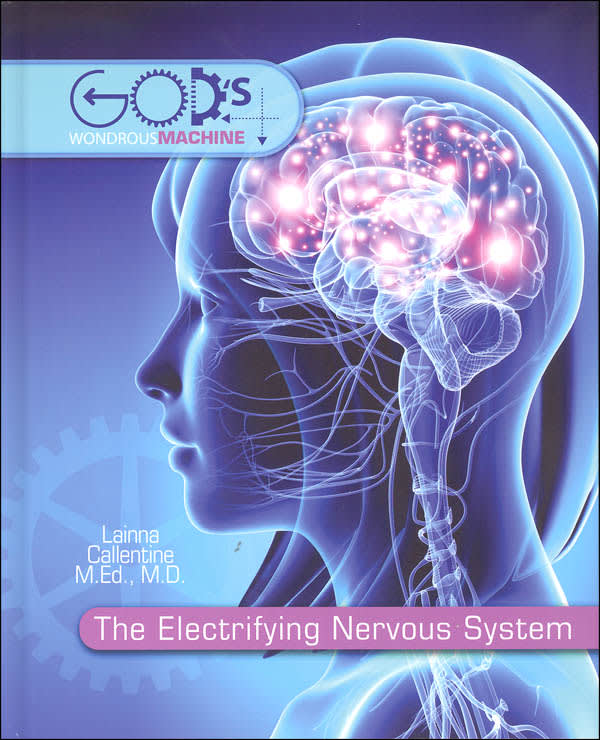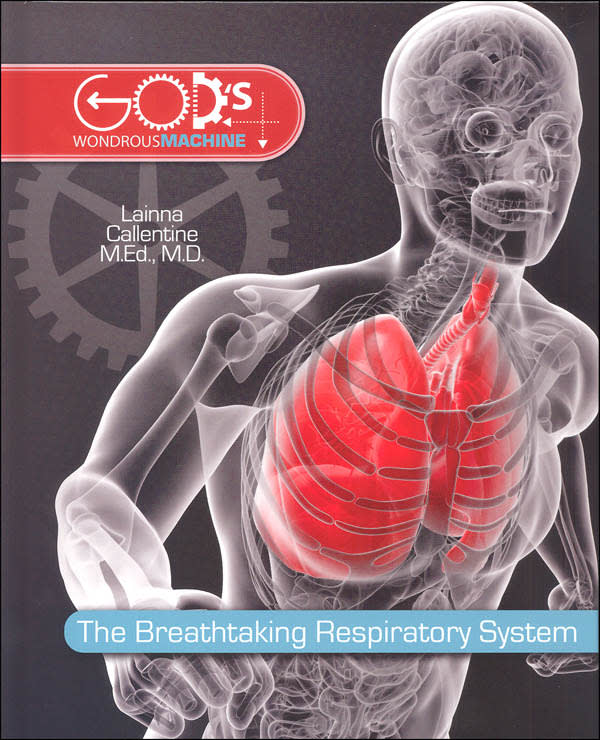Elementary Anatomy: Nervous and Respiratory Systems is a one-year course in human anatomy that is ideal for students in third through sixth grades. While the publisher’s website page recommends the course for those grade levels, the course teacher guide has charts showing activities for grades K-1, 3-5, and 6-8.
This course from Master Books was written based upon the presupposition that man was specially created by God. It includes occasional Bible verses and mentions of God, but it is not heavy-handed.
The design of the course is unusual because it consists of two text books (that might also be used on their own) and one teacher guide that covers both books. The two text books are God’s Wondrous Machine: The Breathtaking Respiratory System and God’s Wondrous Machine: The Electrifying Nervous System. The teacher guide carries the course title.
The two books for this particular course are the first of what the publisher plans to be a nine-book “God’s Wondrous Machine” series. It remains to be seen how they will configure other books into courses.
The course was written by Dr. Lainna Callentine, a pediatrician, credentialed teacher, and homeschooling mom. She has written the books and the teacher guide with homeschoolers as her primary audience.
The hard cover text books are heavily illustrated in full color. Each book is divided into 11 chapters. The science presented in the books is solid and thorough, including appropriate vocabulary. Each book has vocabulary lists near the front of the book for students working at three different levels. Parents can assign the appropriate list to each child. Vocabulary lists are followed by pronunciations and definitions for all of these words. Practical applications and real life situations help illustrate the scientific content. The author rarely writes more than one or two paragraphs of scientific information that read like a textbook without inserting an application, a story, or some other sort of illustration. So the books are easier to read than many science textbooks.
Content in the books extends beyond science to include connections to other areas of study such as history, theology, nutrition, sociology, and psychology. For example, one chapter in each book is devoted to historical developments in the study of the particular body system under consideration. The Electrifying Nervous System includes an article about dreaming and a two-page spread on “brain food,” foods that enhance brain health. In The Breathtaking Respiratory System, an article on polio is followed by an article on “Franklin D. Roosevelt and the March of Dimes” that discusses his creation of the National Foundation for Infantile Paralysis (polio) to help combat polio. Even the science itself is supported directly with articles such as the story of Phineas Gage, a man who suffered traumatic brain damage in the nineteenth century and became a case study on the frontal lobe of the brain (Nervous System, pp. 28-29).
The teacher guide for the course (referred to as the parent lesson planner or PLP in The Electrifying Nervous System) lays out the structure of the entire course with detailed lesson plans indicating on which days to read which pages in a text book, complete worksheets, or complete activities. The teacher guide is divided into two parts, each part covering one of the textbooks. Each textbook will be studied over the course of one semester. A number of charts at the beginning of each section present different ways of using resources in the teacher guide. A lesson plan and an overview apply across the board.
The teacher guide includes learning activities based on Howard Gardner’s educational theory of Multiple Intelligences, so it includes activities described as musical-rhythmic, visual-spatial, verbal-linguistic, logical-mathematical, bodily-kinesthetic, interpersonal, intrapersonal, and naturalistic. An Activity/Worksheet Overview shows which activities and worksheets address which of the eight intelligence types as well as for which of the three grade level spans they are appropriate.
All activities and worksheets for The Electrifying Nervous System should be completed by the oldest students (grades 6-8) with fewer required for grades 3-5, and very few for grades K-2. However, for The Breathtaking Respiratory System the activities and worksheets seem to skew younger with substantially more that are appropriate for the youngest students and some too young for the oldest level. If your children are on the younger end of the spectrum, you might begin with The Breathtaking Respiratory System your first semester so that you will have more age-appropriate activities and worksheets available to you. By the second semester, they might be able to tackle some that would have been too difficult the first semester. The point is that you will need to pick and choose from the activities and worksheets those that best suit each child.
Activities range from simple to challenging. Some are as simple as working with flash cards or measuring your pulse and respiratory rate while resting and after jumping. On the challenging end of the spectrum are activities such as dissecting a sheep’s brain or completing a research report. Similarly, worksheets range from copying Bible verses and labeling parts of the respiratory tract through researching answers to questions.
A unit test for each textbook is included at the back of the teacher guide along with “Portfolio/Rubrics/Reports” forms. Most of the latter help parents evaluate student mastery of the material, but two forms might be used by students: A Scientific Lab Report form and a Learning Log form. Also at the back of the teacher guide are answer keys for activities, worksheets, and tests. The publisher allows parents and teachers to copy pages from the teacher guide for their own family or for up to ten students in a small class group.
The textbooks mention science kits that coordinate with the courses. The kits are not yet available as I write this review, but they should be ready sometime in 2016. Kits are not essential to the courses, but they will definitely be a very helpful addition. They will include all of the difficult-to-obtain resources for the experiments as well as more-detailed instructions. For example, The Nervous System Kit will include items such as a sheep brain, cow spinal cord (over 4 –inch section), a percussion hammer, set of “The Art of Illusion” prints, and a dissection tray. The Respiratory System Kit will include resources such as a dried lung section, a sheep larynx and vocal cords, dissection tray, borax, conical bottom centrifuge tubes, “Y” polypropylene autoclave connectors, and gel glue. Check the publisher’s website for the availability of the kits.
Summary
The textbooks by themselves are interesting both because the content is well written and because the books are colorful and attractive. However, adding the activities and worksheets raises the course to a much higher level because it adds so much variety and so many activities to suit various learning styles. In addition, Christian families will appreciate the God-honoring outlook that pervades the course.












